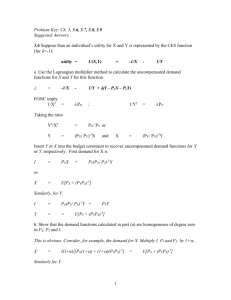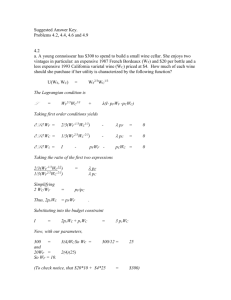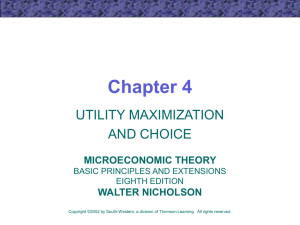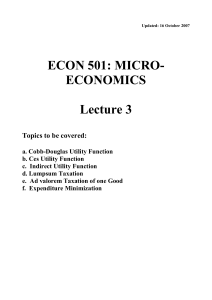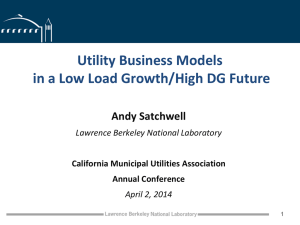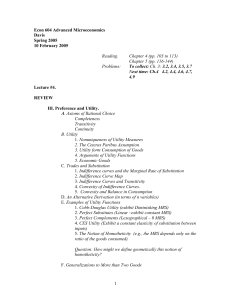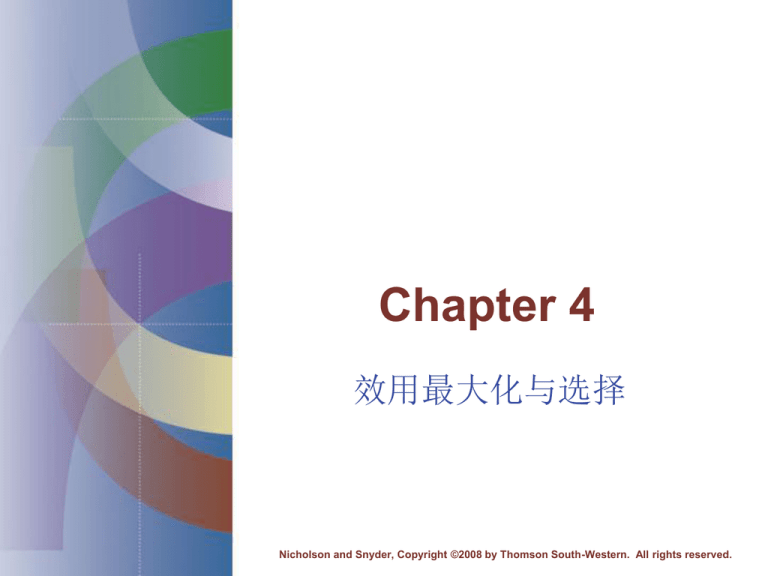
Chapter 4
效用最大化与选择
Nicholson and Snyder, Copyright ©2008 by Thomson South-Western. All rights reserved.
N 种商品情形
• 个人目标是最大化
utility = U(x1,x2,…,xn)
其约束为
I = p1x1 + p2x2 +…+ pnxn
• Set up the Lagrangian:
ℒ = U(x1,x2,…,xn) + (I - p1x1 - p2x2 -…- pnxn)
The n-Good Case
• 内部解(每种商品都消费)的一阶条件:
ℒ/x1 = U/x1 - p1 = 0
ℒ /x2 = U/x2 - p2 = 0
•
•
•
ℒ /xn = U/xn - pn = 0
ℒ / = I - p1x1 - p2x2 - … - pnxn = 0
一阶条件的含义
• For any two goods,
U / x i
pi
U / x j p j
• 这一意味着收入分配的最优条件为
pi
MRS ( x i for x j )
pj
拉格朗日乘数解释
U / x1 U / x 2
U / x n
...
p1
p2
pn
MU x1
p1
MU x 2
p2
...
MU x n
pn
• 为消费支出每单位货币获得的边际效用
– the marginal utility of income
拉格朗日乘数解释
• 在边际上,一种商品价格反映出一个人
对于再购买一单位这种商品的支付意愿
– how much the consumer is willing to pay
for the last unit
pi
MU x i
Lamda=收入的边际效用
角点解Corner Solutions
• 角点解意味着某些商品不消费,最优化
条件变为:
ℒ/xi = U/xi - pi 0 (i = 1,…,n)
Kuhn-Tucker
• If ℒ/xi = U/xi - pi < 0, then xi = 0
• This means that p U / x i MU x
i
i
– 任何商品,它的价格超过其边际价值(上式右
边),消费者将不消费该商品。除此情形外,
一阶条件和正常的一样。
Cobb-Douglas 需求函数
• Cobb-Douglas utility function:
U(x,y) = xy
• Setting up the Lagrangian:
ℒ = xy + (I - pxx - pyy)
• FOCs:
ℒ/x = x-1y - px = 0
ℒ/y = xy-1 - py = 0
ℒ/ = I - pxx - pyy = 0
效用最大化的二阶条件
• 有约束条件的最大化问题,其二阶条件
如果ux1x 2 0,那么H3 0,满足二阶条件
Cobb-Douglas 需求函数
• First-order conditions imply:
y/x = px/py
• Since + = 1:
pyy = (/)pxx = [(1- )/]pxx
• Substituting into the budget constraint:
I = pxx + [(1- )/]pxx = (1/)pxx
Cobb-Douglas 需求函数
• Solving for x yields
I
x*
px
• Solving for y yields
I
y*
py
• 该个人将收入的 %用于购买商品x,%
用于购买商品 y
Cobb-Douglas 需求函数
• Cobb-Douglas效用函数解释实际消费行为
能力有限
– 随着经济条件的改变,消费者在特定商品上的
花费的收入份额经常发生很大变化。
• 需要一个更一般的函数形式。
不变替代弹性CES需求
• Assume that = 0.5
U(x,y) = x0.5 + y0.5
• Setting up the Lagrangian:
ℒ = x0.5 + y0.5 + (I - pxx - pyy)
• FOCs:
ℒ/x = 0.5x -0.5 - px = 0
ℒ/y = 0.5y -0.5 - py = 0
ℒ/ = I - pxx - pyy = 0
不变替代弹性CES需求
• This means that
(y/x)0.5 = px/py
• Substituting into the budget constraint,
we can solve for the demand functions
x*
I
px
p x [1 ]
py
y*
I
py
py [1 ]
px
不变替代弹性CES需求
• 在这种需求函数中,花费在x或y商品上
的支出占收入份额不是常数,而是取决
于价格之比
px x
1
I
1 ( px / p y )
• The higher is the relative price of x, the
smaller will be the share of income
spent on x
不变替代弹性CES需求
• If = -1,
U(x,y) = -x -1 - y -1
• First-order conditions imply that
y/x = (px/py)0.5
• The demand functions are
x*
I
py
px 1
px
0 .5
y*
I
p
py 1 x
py
0 .5
不变替代弹性CES需求
• If = -,固定比例效用函数
U(x,y) = Min(x,4y)
• The person will choose only combinations
for which x = 4y
• This means that
I = pxx + pyy = pxx + py(x/4)
I = (px + 0.25py)x
不变替代弹性CES需求
• Hence, the demand functions are
I
x*
p x 0 .25 p y
I
y*
4 px py
间接效用函数
• 通过最优化的一阶条件可得出x1,x2,…,xn
的最优值
• These optimal values will be
x*1 = x1(p1,p2,…,pn,I)
x*2 = x2(p1,p2,…,pn,I)
•
•
•
x*n = xn(p1,p2,…,pn,I)
间接效用函数
• 将最优消费 x* 值代入效用函数,可得间
接效用函数
maximum utility = U(x*1,x*2,…,x*n)
maximum utility = V(p1,p2,…,pn,I)
• 效用间接取决于商品的价格和收入
一次总付原则
• 效用水平为间接效用函数形式的一个最
重要的应用是一次总付原则。
• 即对消费者一般购买力征税要比对特定
的物品征税更好。同理对穷人收入补贴
。其理由为
– 收入税或补贴使个人可以自由决定如何分配
他的最终收入
– 而对特定商品征税或补贴不但将降低个人购
买力,而且会扭曲其选择。
一次总付原则
• 如果对商品x征税,将提高x价格,使得预
算线内旋,效用最大化的选择将从A点移
到B点。
Quantity of y
B
A
U1
U2
Quantity of x
一次总付原则
• 对x直接征税T=tx1,消费者收入变为:
I ' I tx p x p y ,所以征收相同收入税
时,预算线必经过B点,但最优点变为C点
1
x 1
y
1
Quantity of y
Utility is maximized now at point
C on U3
I’
y1
A
B
x1
C
U3 U1
U2
x2
x*
Quantity of x
一次总付原则
• If the utility function is Cobb-Douglas with
= = 0.5, we know that
I
x*
2 px
I
y*
2 py
• The indirect utility function is
V ( p x , p y , I ) (x*) (y*)
0 .5
0 .5
I
2 p x0.5 p y0.5
一次总付原则
一次总付原则
• If the utility function is fixed proportions
with U = Min(x,4y), we know that
I
x*
p x 0 .25 p y
I
y*
4 px py
• The indirect utility function is
I
V ( p x , py , I ) Min( x *,4 y *) x*
p x 0.25 py
4
I
4y *
4 p x py p x 0.25 py
一次总付原则
• 如果对x征收商品税税率为 $1
– indirect utility will fall from 4 to 8/3
• 相同的收入税将使得收入减少到 $16/3
– indirect utility will fall from 4 to 8/3
• 在固定比例效用下,消费者的偏好为刚醒的
,所以商品消费税没有扭曲选择。
支出最小化
• 效用最大化的对偶问题为支出最小化
– 如何分配收入,以便用最少的支出达到既定的
效用水平
– 支出最小化问题和效用最大化问题相似,但是
约束条件和目标函数与效用最大化问题相反。
支出最小化
• Point A is the solution to the dual problem
Expenditure level E2 provides just enough to reach U1
Quantity of y
Expenditure level E3 will allow the
individual to reach U1 but is not the
minimal expenditure required to do so
A
Expenditure level E1 is too small to achieve U1
U1
Quantity of x
支出最小化
• 个人选择消费 x1,x2,…,xn ,以便最小化
总支出= E = p1x1 + p2x2 +…+ pnxn
受约束于
utility = Ū = U(x1,x2,…,xn)
• x1,x2,…,xn 的最优消费量取决于这些商品
的价格和给定的效用水平。
支出最小化
• 支出函数: 在一组特定的商品价格条件下
,要达到既定的效用水平所必须的最小支
出。
minimal expenditures = E(p1,p2,…,pn,U)
• 支出函数和间接效用函数是互为反函数关
系的。
– 两者都取决于市场价格,但是所受到的约束条
件不同:支出函数的约束为效用,而间接效用
函数的约束为收入。
两个支出函数的例子
• 两种商品的C-D 函数的间接效用函数为
V ( px , py , I )
I
2 p x0.5 p y0.5
• 如果上述函数中的效用(V)与收入(将其看成
“支出”),将效用和支出分别写为U和E,可
得出支出函数
E(px,py,U) = 2px0.5py0.5U
两个支出函数的例子
• 对于前面的固定比例偏好,其间接效用函数
为
I
V ( px , py , I )
p x 0 .25 p y
• 交换效用和支出,可得出其支出函数
E(px,py,U) = (px + 0.25py)U
支出函数的属性
• 齐次性 Homogeneity
– 所有商品价格加倍,所需要的最小支出也加
倍
可见,支出函数是关于所有价格的“一次齐次
函数”
• 关于价格单调不将:E/pi 0 for every
good, i
• 关于价格的凹函数:切线之下
支出函数的凹性
At p*1, the person spends E(p*1,…)
E(p1,…)
Epseudo
当p1变化时,如果消费继
续购买以前消费组合,其
支出函数将为 Epseudo,支
出随价格线性变化。
E(p1,…)
E(p*1,…)
实际上,当P变化时,消
费者会改变其消费组合,
最小化其支出,支出函数
为在 Epseudo 之下,如
E(p1,…)
p*1
p1
Important Points to Note:
• To reach a constrained maximum, an
individual should:
– spend all available income
– choose a commodity bundle such that the
MRS between any two goods is equal to
the ratio of the goods’ prices
• the individual will equate the ratios of the
marginal utility to price for every good that is
actually consumed
Important Points to Note:
• Tangency conditions are only firstorder conditions
– the individual’s indifference map must
exhibit diminishing MRS
– the utility function must be strictly quasiconcave
Important Points to Note:
• Tangency conditions must also be
modified to allow for corner solutions
– the ratio of marginal utility to price will be
below the common marginal benefitmarginal cost ratio for goods actually
bought
Important Points to Note:
• The individual’s optimal choices
implicitly depend on the parameters of
his budget constraint
– observed choices and utility will be implicit
functions of prices and income
Important Points to Note:
• The dual problem to the constrained
utility-maximization problem is to
minimize the expenditure required to
reach a given utility target
– yields the same optimal solution
– leads to expenditure functions
• spending is a function of the utility target and
prices

